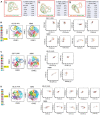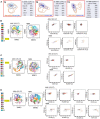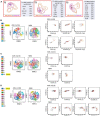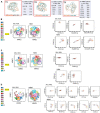Advanced Flow Cytometry Analysis Algorithms for Optimizing the Detection of "Different From Normal" Immunophenotypes in Acute Myeloid Blasts
- PMID: 34650981
- PMCID: PMC8506133
- DOI: 10.3389/fcell.2021.735518
Advanced Flow Cytometry Analysis Algorithms for Optimizing the Detection of "Different From Normal" Immunophenotypes in Acute Myeloid Blasts
Abstract
Acute myeloid leukemias (AMLs) are a group of hematologic malignancies that are heterogeneous in their molecular and immunophenotypic profiles. Identification of the immunophenotypic differences between AML blasts and normal myeloid hematopoietic precursors (myHPCs) is a prerequisite to achieving better performance in AML measurable residual disease follow-ups. In the present study, we applied high-dimensional analysis algorithms provided by the Infinicyt 2.0 and Cytobank software to evaluate the efficacy of antibody combinations of the EuroFlow AML/myelodysplastic syndrome panel to distinguish AML blasts with recurrent genetic abnormalities (n = 39 AML samples) from normal CD45low CD117+ myHPCs (n = 23 normal bone marrow samples). Two types of scores were established to evaluate the abilities of the various methods to identify the most useful parameters/markers for distinguishing between AML blasts and normal myHPCs, as well as to distinguish between different AML groups. The Infinicyt Compass database-guided analysis was found to be a more user-friendly tool than other analysis methods implemented in the Cytobank software. According to the developed scoring systems, the principal component analysis based algorithms resulted in better discrimination between AML blasts and myHPCs, as well as between blasts from different AML groups. The most informative markers for the discrimination between myHPCs and AML blasts were CD34, CD36, human leukocyte antigen-DR (HLA-DR), CD13, CD105, CD71, and SSC, which were highly rated by all evaluated analysis algorithms. The HLA-DR, CD34, CD13, CD64, CD33, CD117, CD71, CD36, CD11b, SSC, and FSC were found to be useful for the distinction between blasts from different AML groups associated with recurrent genetic abnormalities. This study identified both benefits and the drawbacks of integrating multiple high-dimensional algorithms to gain complementary insights into the flow-cytometry data.
Keywords: AML with recurrent genetic abnormalities; Citrus; Infinicyt; SPADE; different-from-normal (DfN); viSNE.
Copyright © 2021 Aanei, Veyrat-Masson, Rigollet, Stagnara, Tavernier Tardy, Daguenet, Guyotat and Campos Catafal.
Conflict of interest statement
The authors declare that the research was conducted in the absence of any commercial or financial relationships that could be construed as a potential conflict of interest.
Figures






References
-
- Byford E. T., Carr M., Ladikou E., Ahearne M. J., Wagner S. D. (2018). Circulating Tfh1 (cTfh1) cell numbers and PD1 expression are elevated in low-grade B-cell non-Hodgkin’s lymphoma and cTfh gene expression is perturbed in marginal zone lymphoma. PLoS One 13:e0190468. 10.1371/journal.pone.0190468 - DOI - PMC - PubMed
LinkOut - more resources
Full Text Sources
Research Materials
Miscellaneous

